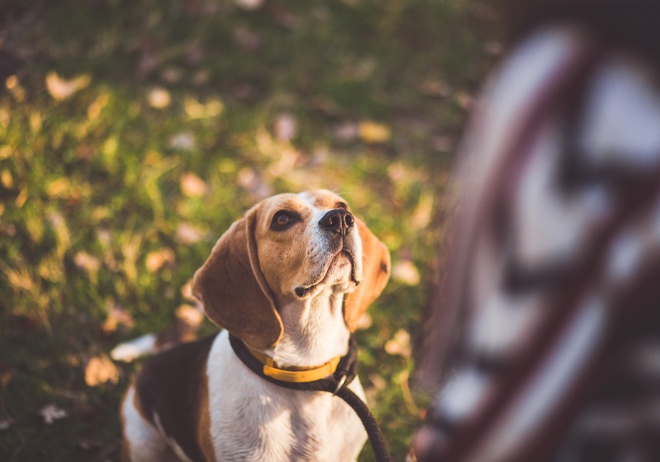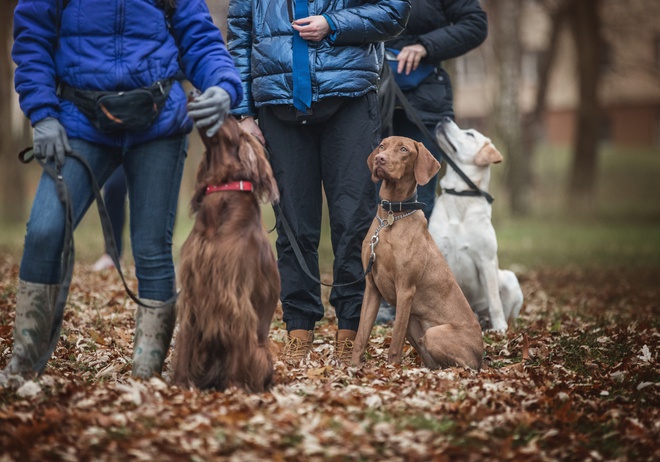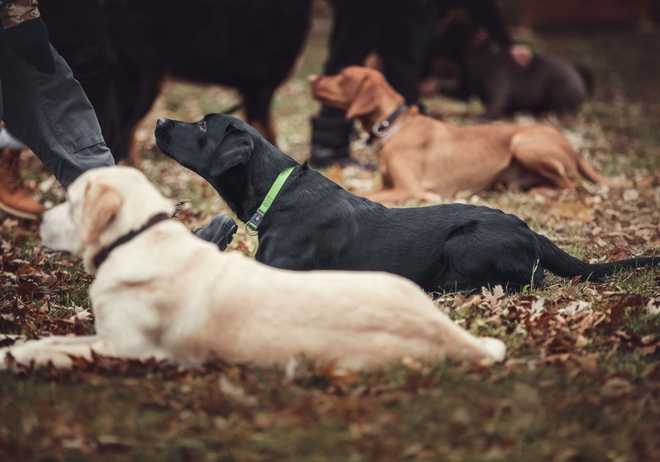How to teach your dog obedience training?
Obedience training is one of the most important dog trainings that you can start even with a puppy. Teaching your dog basic commands will make your life together much easier and even safer for your pet. In this article, you will find all the information to allow you to teach your dog obedience at home.

Reading time : 7 min
Getting a new dog is a wonderful, yet sometimes difficult experience. Having a puppy is certainly a huge responsibility that you put on your shoulders, and the first weeks of life with your new companion might be just as intimidating as they are beautiful. There are certain types of behaviour that you as a dog owner would expect your pet to follow, but that’s not always, or it rarely is, the case. Therefore, obedience training plays an important role in teaching your dog good manners and making them well-behaved. With adequate technique and methods, you and your dog can succeed in making a really good boy (or girl) out of your dog.
TOPICS
Things you should know before starting obedience training

Obedience training, as any other type of dog training, might be a big challenge, especially to the owner that does not have previous training experience. There are several factors that you need to be aware of and take into consideration before you start to obedience train your dog. Make sure to explore the topic thoroughly to choose the option that best suits both your dog’s needs and your own preferences.
What are the different ways to train your dog?
Obedience training is one of the most basic ones, on which depends your dog’s behaviour and their readiness for further, more advanced training and new tricks. Because of the significance of these first training sessions, you should make sure that they’re successful and encourage your dog to learn new things.
You don’t have to wait for your puppy to become an adult dog to start the training. Basic cues can be taught even to puppies, and if you’re insecure about how to train your new puppy, puppy kindergarten or puppy training classes might be a great option for you.
There are various ways to teach your dog and puppy obedience, and your choice depends mostly on how much time and money you’re willing to spend on the training, as well as how involved in it you wish to be.
Group training classes
If you prefer to leave your dog’s training to the professionals, the good option is signing up for a dog training class at a training facility, which you and your pet would attend together. This is also the cheapest option for classes with an instructor, costing around £20 - £70 per session.
During group training sessions, you are under the eye of a professional dog trainer, who can guide you and give you valuable tips. Moreover, this type of training challenges your dog to avoid getting distracted by other dogs, thus teaching them to focus, at the same time integrating socialising in the training program.
On the other hand, group sessions are created to meet the needs of majority of the participants, which means that you might find some classes less helpful or useful than others.
Sessions with a private instructor
If you would rather opt for a more personalised approach that’s tailored to your dog’s needs, you can hire a private, accredited dog trainer. Working with a pet instructor can be a perfect opportunity to get to know your dog better and get professional training tips. However, bear in mind that private training will be more costly than the group dog training classes, raging between £40 and £90 per session.
Dog obedience school
For the owners who see the need to obedience train their dog, but don’t have time for group or private sessions, there’s an option to enrol for a dog obedience school or a boot camp. You can leave your dog for a short period under the supervision of the professional instructors, who will teach the dog without your personal input.
DIY approach at home
As any other type of training, obedience training can be an amazing opportunity for you to create or strengthen the bond between you and your dog. That’s the reason why a lot of dog owners decide on house training, using DIY dog training methods. There’s plenty of materials prepared by professional trainers that can be found online, including dog training videos, so even if you’re taking the first steps in dog training, you can be confident to find the right strategy for you and your dog.
How long does obedience training take?
The amount of time you need to spend to teach your dog obedience depends on several factors, the frequency and duration of the training being among the most important ones.
The type of training you choose also plays a vital role. If you train your dog on your own, it might take you between 4 weeks and 4 months to successfully finish the training, whereas obedience training classes would usually last 6 to 10 weeks. Each dog has their own learning pace, so don’t try to force your dog to learn faster, as it may bring the opposite result.
10 questions to test your pet training knowledge
Do you know everything there is to know about training dogs and cats? Answer our 10 questions to find out!
Preparation for the obedience training

If you have time and willingness to obedience train your dog at home, there are several things you need to take into consideration before starting the training sessions. Good preparation and strategy are the key to success.
Equipment
The list of the equipment you will need at the start of obedience training is not long, nor does the toolkit you’ll use have to be a big expense. However, there are several things you should purchase before you start the training sessions.
Firstly, as in any other type of training, we recommend sticking to positive reinforcement method. This means that the dog should be rewarded every time they behave in the way you expect from them. To reward your dog, you should have a bag of small, healthy treats at hand. During one training session, you will give plenty of them to your dog, which is why they should be really small, so that the dog doesn’t get full and lazy.
Apart from the treats, you will also need a short leash. It will be particularly useful while teaching your dog “heel” command, but it is also important that your dog learns to behave politely while walking by your side at any time.
Session plan and methods
Planning your dog’s training and learning theory might be a strenuous task, but it is a necessary one if you wish to succeed in teaching your dog basic skills. You need to understand that your full commitment to the training is essential. Start by learning the techniques of teaching basic obedience commands. Then move on to plan a schedule of the training sessions, bearing in mind that it’s best to start the sessions around the same time each day to introduce a structure to your dog’s daily routine. Keep the sessions short, not exceeding 15 minutes, and try teaching one command per session not to confuse your dog with various tasks at once.
5 basic commands to start obedience training of your dog

Dog obedience training is supposed to teach your dog how to behave in social situations, and it is believed to be the most important type of training. It is absolutely necessary if you plan to try more advanced tricks with your dog in the future and it might be beneficial for your dog’s safety. The end goal of the training process should be to make your dog reactive to your words and execute the actions on command. There are five basic cues that you can start your obedience training with: sit, down, stay, come, and heel.
Sit and down commands
Both sit and down are commands that can be taught with two different methods: capturing or luring. In capturing you wait for your dog to either sit or lie down and once they do it, you give them a treat. Repeating this exercise will make the dog associate the action with a reward that they get. In luring, you don’t wait for your dog to execute the action you expect from them, but you lure them with a snack to the desired position.
Stay command
The main goal in teaching your dog stay command is for them to learn to remain in the position until you give them the release cue. Therefore, you should start this training by teaching your dog the release word. Once they learn this command, you can go on to practice sitting on verbal and/or visual cue.
Come command
For training a recall, it’s best to choose a quiet space, preferably indoors, to minimise the possibility of your dog getting distracted. You may either use a “come” cue or your pet’s name to make them come to you. At first, feed them treats after giving the command, even if the dog doesn’t do anything. After several repetitions, you can try dropping the treats on the floor further and further away from the dog so that they come to you.
Heel command
Heel is a command used to teach dogs loose-leash walking by the owner’s side. If your puppy has never worn a leash before, make sure that they are comfortable wearing it before starting with the training. You can either use “heel” command, but you can also say “forward” and “let’s go,” as long as you’re consistent and not changing the word you use.
10 questions to test your pet training knowledge
Do you know everything there is to know about training dogs and cats? Answer our 10 questions to find out!
Tips to successful dog obedience training at home

Once you’re fully prepared to start dog obedience training at home, there are several things you need to remember.
Use positive reinforcement
Although some people still use aversive-based method (otherwise called discipline based), we strongly encourage you to base your training in positive reinforcement. No matter how difficult the classes get and how much your patience is being tested, resorting to violence and punishment may result in aggressive or anxious behaviour in your dog.
Instead, adopt a positive approach – make sure to reward your dog every time they behave in a desired way, at the same time withdrawing the reward in case of unwanted, bad behaviour. Remember that obedience training is a great opportunity for you to bond with your dog, so use your chances to make your dog trust you and love you more.
Be consistent
Consistency is one of the most important parts of obedience training, without which all your efforts might go to waste. Remember to reinforce the same rules regardless of the situation, otherwise your dog can get easily confused. Moreover, you need consistency in cues – after deciding on one verbal command, stick to it and don’t change it.
You might sometimes be tempted to break the training session to play with your dog, but by doing that you will just show your dog that you don’t take the training seriously. Wait until you’re done with the exercises planned for a day and reward your dog with a play afterwards.
Teaching obedience to your dog might seem to be an intimidating and difficult task. However, with a well-thought strategy, right equipment and eagerness, every dog owner can become a dog trainer, at the same time building a great bond between the two. This can only bring advantages, as trained dogs are much more obedient and thus safer.
Continue reading our guide
This article is a part of a complete guide on the subject. Do not miss the next chapters.
Do you know everything there is to know about training pets?
Answer our 10 questions to test your pet training knowledge.


